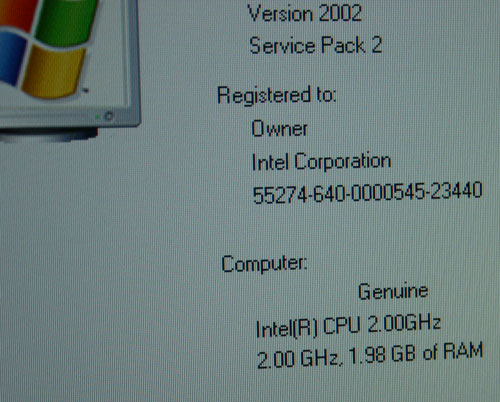Intel's 65nm Processors: Overclocking Preview
by Anand Lal Shimpi on October 25, 2005 12:05 AM EST- Posted in
- CPUs
Final Words
Intel's move to 65nm is very much on track; today, we are able to test working samples at shipping clock speeds of Intel's 65nm Pentium 4 and Pentium D processors. This means that quite a bit of work has taken place between two IDFs ago where we first saw Presler at 2.0GHz and today when we're able to overclock the core to 4.25GHz with minimal effort.
The new cores do definitely overclock much better than their predecessors, and they will allow any serious overclocker to reach speeds greater than 4.0GHz effortlessly. Most exciting to us was the 4.25GHz overclock that we saw on Presler, as a 4.25GHz Pentium D will truly be a formidable opponent to AMD's Athlon 64 X2. Cedar Mill offered reasonable overclocking headroom as well, but we would have liked to see a 5.0GHz overclock on standard air cooling, given that reaching 4.0GHz is possible today on Prescott.
The reduction in power consumption is impressive, but still not enough to give Intel an advantage over AMD, which makes things better, but hardly fixes the problem in our opinion. Unfortunately, we will have to wait for Intel's next-generation processors for a true competitor to AMD's low power Athlon 64s.
We have concluded this preview with one major unanswered question: how well does Intel's Presler perform compared to Smithfield, given that each core in Presler has twice the L2 cache of those in Smithfield? With our curiosities piqued, it won't be long before we try to answer that question...
Intel's move to 65nm is very much on track; today, we are able to test working samples at shipping clock speeds of Intel's 65nm Pentium 4 and Pentium D processors. This means that quite a bit of work has taken place between two IDFs ago where we first saw Presler at 2.0GHz and today when we're able to overclock the core to 4.25GHz with minimal effort.

Presler was running at only 2.0GHz less than a year ago.
The new cores do definitely overclock much better than their predecessors, and they will allow any serious overclocker to reach speeds greater than 4.0GHz effortlessly. Most exciting to us was the 4.25GHz overclock that we saw on Presler, as a 4.25GHz Pentium D will truly be a formidable opponent to AMD's Athlon 64 X2. Cedar Mill offered reasonable overclocking headroom as well, but we would have liked to see a 5.0GHz overclock on standard air cooling, given that reaching 4.0GHz is possible today on Prescott.
The reduction in power consumption is impressive, but still not enough to give Intel an advantage over AMD, which makes things better, but hardly fixes the problem in our opinion. Unfortunately, we will have to wait for Intel's next-generation processors for a true competitor to AMD's low power Athlon 64s.
We have concluded this preview with one major unanswered question: how well does Intel's Presler perform compared to Smithfield, given that each core in Presler has twice the L2 cache of those in Smithfield? With our curiosities piqued, it won't be long before we try to answer that question...










43 Comments
View All Comments
Viditor - Tuesday, October 25, 2005 - link
Fair enough...but certainly not with a Netburst chip. If I were AMD, I probably wouldn't release much info at this point either...
1. As this shows, there really isn't any competition until the end of 06.
2. Anouncing any concrete changes early risk creating an http://en.wikipedia.org/wiki/Osborne_effect">Osbourne effect.
3. Anticipation of the new Intel architecture is too far down the track to cut into current AMD sales.
While there certainly are a few hints at some of the things to come (which AT mentions http://www.anandtech.com/cpuchipsets/showdoc.aspx?...">here), there have been any number of stealth releases from AMD in the past (for example, nobody knew how much cooler the Rev E chips would end up being).
Sadly for us, we just can't predict what is going to happen at the end of next year...
How good will Conroe (et al) actually perform?
What will AMDs products actually be?
Doormat - Tuesday, October 25, 2005 - link
Yea, the chips still consume a whole lot of power, but 4.25GHz dual core is very competitive - and from some leaked roadmaps, AMD has the X2-5000 on tap for Q1'06 as well.I'm curious to know what the load temps were for those 4+GHz overclocks. And on the stock Intel HSF, right? I wonder what those crazy guys who use LN2 will get them too...
Kalessian - Tuesday, October 25, 2005 - link
Yawn, I overclocked my 1.8ghz Venice by 1gz a long time ago, and 1ghz on a K8 is much more powerful than 1ghz on a p4.You guys should have tested the lower end CPUs (2.8ghz or 3.2ghz) to test the limits. If those could push a 1500mhz+ increase I'd be impressed.
I bet I run cooler, too.
Not that progress is bad, mind you. I'm all for 65nm.